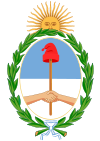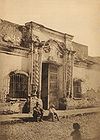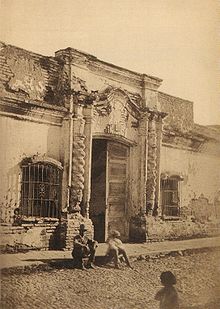- Congress of Tucumán
-
History of Argentina 
This article is part of a seriesPre-Columbian Indigenous peoples Colonial Argentina Viceroyalty of the Río de la Plata British invasions Independence May Revolution War of Independence Congress of Tucumán Civil War Bernardino Rivadavia Juan Manuel de Rosas French blockade of the Río de la Plata Anglo-French blockade of the Río de la Plata Building a nation 1853 Constitution Conquest of the Desert Generation of '80 The Radicals in Power (1916-1930) The Infamous Decade Peronism Juan Perón and Eva Perón General Confederation of Labour Argentina from 1955 to 1976 Revolución Libertadora Revolución Argentina Montoneros and ERP National Reorganization Process Dirty War Falklands War
(Guerra de las Malvinas)Democracy and Crisis Trial of the Juntas December 2001 riots Present day Argentina History by topic Economic Historiography Military Nationality
Argentina Portal
The Congress of Tucumán was the representative assembly, initially meeting in Tucumán, that declared the independence of the United Provinces of South America (modern-day Argentina) on July 9, 1816, from the Spanish Empire.
Following the May Revolution of 1810, the Viceroyalty of the River Plate had been replaced by the Primera Junta. The provinces had been moving towards full independence but royalist forces had had success in battle in what was the Viceroyalty of Peru and were threatening José de San Martín and Buenos Aires.
On April 15, 1815, a revolution ended the mandate of Carlos María de Alvear and called a General Congress. Delegate deputies, each representing 15,000 inhabitants, were sent from all the provinces to the sessions that started on March 24, 1816. Nevertheless, several territories that until then belonged to the Viceroyalty of the River Plate did not send any delegates: the Banda Oriental ('Eastern Bank', today Uruguay) that was faithful to Artigas; Paraguay, which had already proclaimed its independence; and the provinces of the Gran Chaco and Mesopotamia, still fighting the aboriginal resistance. Representatives of what is now Bolivia were however present.
The congress was inaugurated in the Tucumán home of Francisca Bazán de Laguna, with 33 deputies, and as had been decided, the presidency of the congress was rotated monthly. Because the congress had freedom to choose the topics to discuss, there were endless discussions. Voting finally ended on July 9, with the declaration of independence of the country. At the time the president of the Congress was Francisco Narciso de Laprida, delegate from San Juan Province. Subsequent discussions centred on the form of government that the young state should have.
The congress continued its work in Buenos Aires in 1817, but it dissolved in 1820 after the Battle of Cepeda that deepened the differences between Unitarians and Federals.
The house where the declaration was made was rebuilt and is now a museum and monument, the House of Tucumán.
Signatories of the declaration
- Francisco Narciso de Laprida, Deputy for San Juan, President
- Mariano Boedo, Deputy for Salta, Vice-president
- José Mariano Serrano, Deputy for Charcas (present Bolivia), Secretary
- Juan José Paso, Deputy for Buenos Aires, Secretary
- Dr. Antonio Sáenz, Deputy for Buenos Aires
- Dr. José Darragueira, Deputy for Buenos Aires
- Friar Cayetano José Rodríguez, Deputy for Buenos Aires
- Dr. Pedro Medrano, Deputy for Buenos Aires
- Dr. Manuel Antonio Acevedo, Deputy for Catamarca
- Dr. José Ignacio de Gorriti, Deputy for Salta
- Dr. José Andrés Pacheco de Melo, Deputy for Chichas (present Bolivia)
- Dr. Teodoro Sánchez de Bustamante, Deputy for Jujuy
- Eduardo Pérez Bulnes, Deputy for Córdoba
- Tomás Godoy Cruz, Deputy for Mendoza
- Dr. Pedro Miguel Aráoz, Deputy for Tucumán
- Dr. Esteban Agustín Gazcón, Deputy for Buenos Aires
- Pedro Francisco de Uriarte, Deputy for Santiago del Estero
- Pedro León Gallo, Deputy for Santiago del Estero
- Pedro Ignacio Rivera, Deputy for Mizque (present Bolivia)
- Dr. Mariano Sánchez de Loria, Deputy for Charcas (present Bolivia)
- Dr. José Severo Malabia, Deputy for Charcas (present Bolivia)
- Dr. Pedro Ignacio de Castro Barros, Deputy for La Rioja
- Lic. Gerónimo Salguero de Cabrera y Cabrera, Deputy for Córdoba
- Dr. José Colombres, Deputy for Catamarca
- Dr. José Ignacio Thames, Deputy for Tucumán
- Friar Justo de Santa María de Oro, Deputy for San Juan
- José Antonio Cabrera, Deputy for Córdoba
- Dr. Juan Agustín Maza, Deputy for Mendoza
- Tomás Manuel de Anchorena, Deputy for Buenos Aires
Reference
Congress of Tucumán Representatives Tomás de Anchorena · Juan Agustín Maza · José Antonio Cabrera · Justo de Santa María de Oro · José Ignacio Thames · José Colombres · Gerónimo Salguero · Pedro Ignacio de Castro Barros · José Severo Malabia · Mariano Sánchez de Loria · Pedro Ignacio Rivera · Pedro León Gallo · Pedro Francisco de Uriarte · Esteban Agustín Gazcón · Pedro Miguel Aráoz · Tomás Godoy Cruz · Eduardo Pérez Bulnes · Teodoro Sánchez de Bustamante · José Andrés Pacheco de Melo · José Ignacio de Gorriti · Manuel Antonio Acevedo · Pedro Medrano · Cayetano José Rodríguez · José Darragueira · Antonio Sáenz · Juan José Paso · José Mariano Serrano · Mariano Boedo · Francisco Narciso de Laprida
Rulings Argentine Declaration of Independence - Argentine Constitution of 1819 - Flag of Argentina chosen as National flagSee also Categories:- Argentine War of Independence
- Argentine historical congresses
- History of Bolivia
- Tucumán Province
- 1816 establishments in Argentina
- 1820 disestablishments
- Defunct unicameral legislatures
Wikimedia Foundation. 2010.

